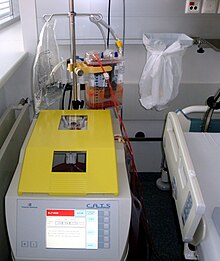Automated autotransfusion
As autotransfusion ( MAT ) refers to the method, in which during or after an operation, which is accompanied by a strong loss of blood, blood absorb the patient from the surgical area and can recycle to return the patient promptly to re- transfuse . This procedure is used to reduce the need for foreign blood transfusions because, despite the many tests, there is always a residual risk of transfusion incidents.
The MAT is usually carried out by the treating anesthetist , requires special equipment and is much more complex and expensive than the alternative method of drainage blood retransfusion. An important advantage of the MAT is the fact that the erythrocytes obtained (or whole blood, depending on the method) are almost completely freed from undesired foreign substances (e.g. cell debris, inflammatory factors), which leads to fewer side effects.
From the name of one of the most common devices for the MAT derives the trivial name of the process Cell Saver - mainly used in specialist circles . The “cell saver” centrifuges the collected blood to separate the erythrocytes, which are ready for autotransfusion after a washing process. Other machines are also known for their purpose, such as the “Hemobag” known in cardiac surgery, which is able to cleanse all components of the blood and to give them back as whole blood concentrate.
The patient must always be informed about the implementation as well as the risks and side effects of a machine autotransfusion and give his written consent. The return of the collected blood must take place within six hours due to possible germ growth. For autologous blood preparations obtained perioperatively, the AB0 bedside test can be dispensed with if these preparations remain directly with the patient and there has been no change in room or personnel between removal and return. Otherwise, an ABO bedside test of the preparation and the patient must be carried out.
Anticoagulant
So that the collected whole blood does not coagulate before preparation, it must be inhibited. This is achieved by adding a rinsing solution with heparin to the tip of the teat. The ratio between the collected blood and the anticoagulant rinsing solution should be around 5: 1. Most of the added heparin is removed again during processing by centrifugation and washing. The remaining blood lacks the plasmatic coagulants and thrombocytes, so that anticoagulation is no longer necessary. In patients with heparin intolerance ( e.g. HIT II ), the small amounts of heparin remaining in the return blood could cause problems. As part of an experimental study, danaparoid was used as a heparin substitute at a dose of 3-4.5 units per ml of rinsing solution.
Contraindications
Contraindications for a MAT make operations on germ contaminated (z. B. peritonitis , osteomyelitis ) or malignant neoplastic tissue. It would in these cases, the risk that the patient bacteria or cancer cells in the bloodstream would return, since during centrifugation and washing of the collected blood this cannot be completely freed from bacteria or tumor cells . In prostate operations , for. B. found that in 16% of the cases tumor cells were present and 80% of the collected blood had a high bacterial load. A spread of these bacteria or tumor cells would be the consequence, with the consequences of a potential sepsis or tumor seeding . For this reason, intraoperative machine autotransfusion should not be used for malignancy operations or interventions with bacterial contamination.
Web links
- VE Tumbass, Y. Schmitt, G. Schröter, A. Henn-Beilharz, C. Krier: Automated autotransfusion (MAT) also for transurethral resection of the prostate adenoma (TUR-P)? - Investigations of the prepared washed erythrocyte concentrates (AGEK) before a possible retransfusion In: Anästhesiol Intensivmed Emergency Med Schmerzther 1996; 31 (2): 77-84 doi : 10.1055 / s-2007-995876 (currently unavailable)
Individual evidence
- ↑ Erythrocyte quality after automated autotransfusion and wound blood drainage from Der Anaesthesist : Verlag Springer-Medizin, Issue 50, Issue 1 Supplement, January 2001 ( ISSN 0003-2417 )
- ↑ The Hemobag ( Memento of the original from February 23, 2014 in the Internet Archive ) Info: The archive link was automatically inserted and not yet checked. Please check the original and archive link according to the instructions and then remove this notice. , Brief description on the product page (English)
- ↑ Guidelines for the collection of blood and blood components and for the use of blood products (haemotherapy) - Second guideline amendment 2010
- ↑ U. von Lüpke, A. Marx, R. Teßmann, E. Lindhoff-Last: Danaparoid (Orgaran) for anticoagulation in automatic autotransfusion with Cell Saver 5 (Haemonetics). In: The anesthesiologist. 50, 2001, pp. 26-31, doi : 10.1007 / s001010050959 .
